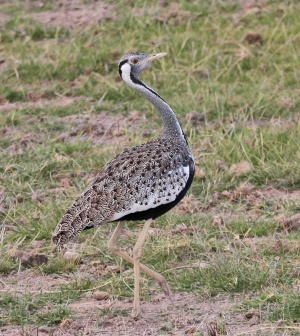| (12 intermediate revisions by 8 users not shown) | |||
| Line 1: | Line 1: | ||
| − | [[ | + | [[Image:Hartlaub s bustard - turmi 1b.jpg|thumb|550px|right|Male<br />Photo by {{user|volker+sthamer|volker sthamer}}<br />Turmi, [[Ethiopia]]]] |
| − | ; | + | ;[[:Category:Lissotis|Lissotis]] hartlaubii |
==Identification== | ==Identification== | ||
| − | + | Male 60 cm (23½ in) | |
| + | *Thick black post-ocular line | ||
| + | *Thick black line from the eye down to the throat | ||
| + | *Separated by white spot | ||
| + | *Blackish lower back, rump and tail | ||
| + | ====Similar Species==== | ||
| + | [[Image:090613 Hartlaub's Bustard 1864.jpg|thumb|300px|right|Immature male. Note the mantle feathers showing the pale "spikes" with dark centres characteristic of this species<br />Photo by {{user|Glen+Tepke|Glen Tepke}}<br />[[Amboseli National Park]], [[Kenya]], 13 June 2009]] | ||
| + | Similar to [[Black-bellied Bustard]]. Hartlaub should show nice white spikes on upperparts (white margins) combined with reduced dark centers. [[Topography#Wings|Tertials]] are hardly visible (barred in Black-bellied, uniform in Hartlaub) | ||
==Distribution== | ==Distribution== | ||
| − | [[Africa]] | + | [[Africa]]: found from eastern [[Sudan]] to [[Ethiopia]], [[Somalia]], northeastern [[Uganda]] and northern [[Tanzania]]. |
| − | |||
==Taxonomy== | ==Taxonomy== | ||
| + | This is a [[Dictionary_M-S#M|monotypic]] species<sup>[[#References|[1]]]</sup>. | ||
| + | {{Eupodotis vs. Lissotis}} | ||
==Habitat== | ==Habitat== | ||
| + | Tall grassland in open areas with scattered acacia trees. | ||
==Behaviour== | ==Behaviour== | ||
| − | + | ====Diet==== | |
| + | There is little information; they are known to eat invertebrates and some vegetable matter. | ||
| + | ==References== | ||
| + | #{{Ref-Clements6thAug16}}#Handbook of the Birds of the World Alive (retrieved May 2017) | ||
| + | #Kenya Birds | ||
| + | {{ref}} | ||
==External Links== | ==External Links== | ||
| − | + | {{GSearch|"Lissotis hartlaubii" {{!}} "Eupodotis hartlaubii" {{!}} "Hartlaub's Bustard"}} | |
| − | [[Category:Birds]] [[Category: | + | {{GS-checked}}1 |
| + | <br /> | ||
| + | <br /> | ||
| + | [[Category:Birds]] [[Category:Lissotis]] | ||
Latest revision as of 18:53, 24 November 2023
- Lissotis hartlaubii
Identification
Male 60 cm (23½ in)
- Thick black post-ocular line
- Thick black line from the eye down to the throat
- Separated by white spot
- Blackish lower back, rump and tail
Similar Species

Photo by Glen Tepke
Amboseli National Park, Kenya, 13 June 2009
Similar to Black-bellied Bustard. Hartlaub should show nice white spikes on upperparts (white margins) combined with reduced dark centers. Tertials are hardly visible (barred in Black-bellied, uniform in Hartlaub)
Distribution
Africa: found from eastern Sudan to Ethiopia, Somalia, northeastern Uganda and northern Tanzania.
Taxonomy
This is a monotypic species[1].
Eupodotis vs. Lissotis
Some authorities (Sibley & Monroe, 1996) lump the genus Lissotis within Eupodotis. however there now seems to be a consensus for using Lissotis..
Habitat
Tall grassland in open areas with scattered acacia trees.
Behaviour
Diet
There is little information; they are known to eat invertebrates and some vegetable matter.
References
- Clements, J. F., T. S. Schulenberg, M. J. Iliff, D. Roberson, T. A. Fredericks, B. L. Sullivan, and C. L. Wood. 2016. The eBird/Clements checklist of birds of the world: v2016, with updates to August 2016. Downloaded from http://www.birds.cornell.edu/clementschecklist/download/
- Handbook of the Birds of the World Alive (retrieved May 2017)
- Kenya Birds
Recommended Citation
- BirdForum Opus contributors. (2025) Hartlaub's Bustard. In: BirdForum, the forum for wild birds and birding. Retrieved 18 May 2025 from https://www.birdforum.net/opus/Hartlaub%27s_Bustard
External Links
GSearch checked for 2020 platform.1




